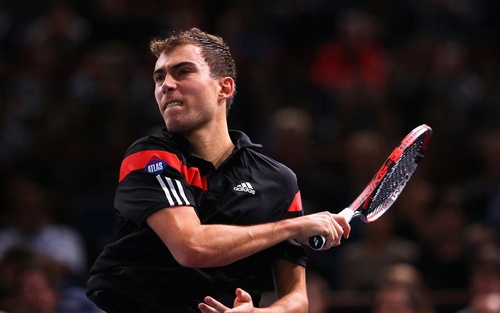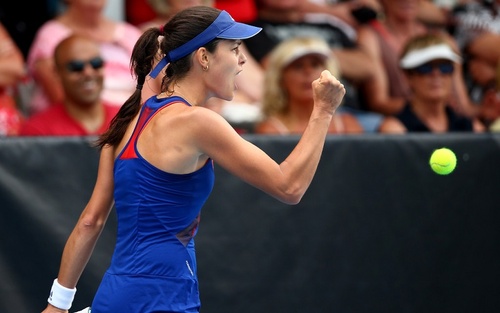Don't miss any stories → Follow Tennis View
Follow2014 Australian Open: Dark Horses to Watch (ATP/WTA)
After profiling the contenders vying for the title at the 2014 Australian Open, this series of previews shifts to the dark horses. Or, if you prefer, the banana peels. Although none of these men or women harbors real hope of claiming the trophy, they might cause the downfall of favorites Down Under.
ATP:
Milos Raonic: At the US Open last fall, the Canadian tower of power marched to the brink of his first major quarterfinal before yielding to Richard Gasquet in five nail-biting sets. Raonic always will live and die by his serve, causing purists to lament his lack of variety. All the same, he shares the innate patience of the sport’s other big men, which will aid him in the best-of-five format. Advancing to his first Masters 1000 final in 2013, Raonic has established himself as the most developed of the ATP’s rising stars. The high bounce on the Melbourne courts might add even more kick to a serve heavy with it.

Jerzy Janowicz: Less consistent than Raonic overall, Janowicz already has achieved something that his peer has not in reaching a major semifinal at Wimbledon last summer. Like Raonic, though, Janowicz has not yet defeated the game’s two leading champions in Rafael Nadal and Novak Djokovic. His unpredictable results have given him few opportunities to clash with the current greats, and he must learn how to master his emotions more smoothly to avoid upsets. Fast surfaces probably suit Janowicz better than the courts in Melbourne, where he appears for just the second time.
Grigor Dimitrov: So slowly did this latest “Baby Federer” develop that many observers wondered whether he would ever develop at all. Dimitrov still has not advanced past the first week at any major, and he has survived the second round only once. But Maria Sharapova’s romantic interest belongs here because of his budding success against the elite, including an upset of Djokovic in Madrid last spring. Dimitrov also extended Nadal to a final set twice last year while serving for sets against Andy Murray and Roger Federer. His first title came last fall at the expense of David Ferrer.
Ernests Gulbis: Creating headlines with his mouth as often as his racket, Gulbis inspires a wide range of reactions. The explosive shot-maker seems to enjoy courting controversy on and off the court, but not until last spring did his bite come close to matching his bark. His appetite for the spotlight accompanies a tendency to play to the level of the competition, rising to the occasion only against opponents of note. Gulbis nearly derailed Nadal’s championship runs in Indian Wells and Rome last year, while he also owns two victories over Federer and one apiece over Djokovic and Murray.
Marin Cilic: Introverted and bland, the Croat contrasts starkly in personality with the other men on this list. The revelation that he had taken a banned substance (perhaps innocently) last spring thus came as a shock. Rebuilding his reputation and ranking may offer Cilic exactly the motivation that he needs to avoid plateauing as a solid but sub-elite talent. Those who witnessed his charge to the Australian Open semifinals in 2010 must have expected more to come from his balanced baseline game. No serious injuries have sidelined him, but the inner fire has not ignited so far.
Bernard Tomic: Some players shine their brightest on home soil, while others turn into helpless shadows of themselves. If Samantha Stosur falls in the second group, Tomic surely falls in the first. His only title to date came at Sydney a year ago, and he reached the second week of the Australian Open as a teenager in 2012. Like Gulbis, Tomic excites and alienates by turns, causing many to question his competitive resilience. What cannot be questioned is the variety of tools in his arsenal. With the right coach, and more distance from his pugnacious father, the sky is the limit.
Lleyton Hewitt: Few men from the same nation could be more different than Tomic and Hewitt. While the younger man personifies quirkiness and spontaneity, the older man has forged a career from sheer grit and consistency. Hewitt is the only man outside the top 10 who has won a major title in singles, although he never has lifted the Norman Brookes trophy. But he created the headline of the pre-Melbourne swing by stunning Federer in Brisbane to win his first hard-court title since 2007. Expect evening heroics from Hewitt in Rod Laver Arena as he nears his 33rd birthday.
WTA:
Sloane Stephens: Last year’s Australian Open marked a pivotal breakthrough for Stephens, who surged to her first major semifinal. Outside a staggering upset of a staggering Serena Williams, however, she defeated no opponent of note en route to that stage. Similar trends at the other majors allowed her to reach the second week at all of them. Much lies at stake for Stephens when she defends the most significant result of her career to date, but can she defeat elite opponents when they are healthy? Despite the hubbub surrounding her, she never has reached the final at a WTA tournament of any level.

Ana Ivanovic: Once known as “Aussie Ana,” Ivanovic won plenty of warm hearts Down Under when she rolled to the 2008 final. Few rays of sunshine have fallen on the Serb over the last five years, especially outside the fall indoor season. But Ivanovic started 2014 by claiming her first title on an outdoor hard court since Indian Wells 2008, and that momentum from Auckland positions her for a confident run. She also reached the quarterfinals at the US Open last fall, where she threatened to upset Victoria Azarenka, although her last several appearances in Melbourne have been indifferent at best.
Ekaterina Makarova: Since last spring, the Russian with the fiery hair and fiery temper has defeated half of the women ranked in the current top 10. Combining lefty angles with dexterity in the forecourt, Makarova has reached the quarterfinals at three of the last four hard-court majors, including each of the last two Australian Opens. Her upset of Serena Williams at the 2012 event ranks among the most shocking there in recent memory, and she ambushed Jelena Jankovic this week in Sydney. But she will hope to avoid countrywoman Maria Sharapova, who has ended her last two Melbourne runs.
Eugenie Bouchard: Just inside the seeding cut-off, this teenage prodigy from north of the border looks to extend an eye-opening fall. The closing stages of Bouchard’s 2013 campaign saw her reach a maiden final in Osaka after a maiden Premier Five quarterfinal in Tokyo. She split her two matches with Stephens during that span, both in three sets, so a renewal of what looks like a future marquee rivalry would intrigue. Bouchard started 2014 at the Hopman Cup, where she took a set from world No. 5 Agnieszka Radwanska. She appears in an Australian Open main draw for the first time.
Laura Robson: The talent long has been there, but the consistency rarely has. A spunky youngster who rarely feels the weight of British expectations, Robson already has produced her share of flashy victories at majors. She sent Kim Clijsters into retirement at the 2012 US Open and outlasted Petra Kvitova in a 20-game final set on Rod Laver Arena last year. On the other hand, Robson unleashed a deluge of double faults last season, a weakness that could cripple her against any opponent. A mediocre finish to 2013 leaves her looking for a chance to bounce back in Hobart this week.
Venus Williams: When she came to Melbourne as an elite champion, the elder Williams sister suffered some of her more embarrassing stumbles, such as losses to Tsvetana Pironkova and Carla Suarez Navarro. Now she aims to play the role of spoiler, which did not go well last year there against Maria Sharapova. A strong week in Auckland, ending in a runner-up showing, should give Venus more confidence heading to Melbourne this year. Never discount the experience and competitive tenacity of a seven-time major champion, unless her body betrays her.










